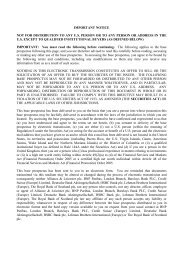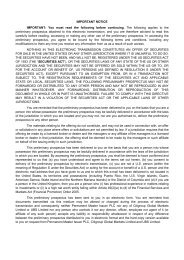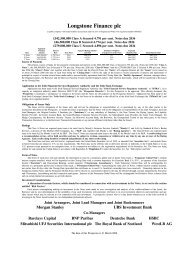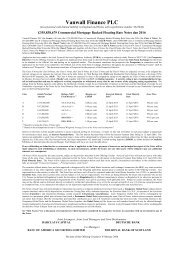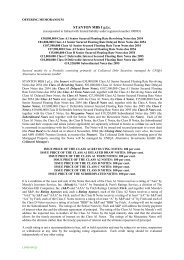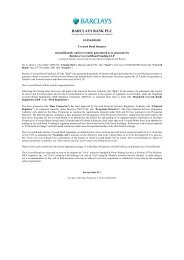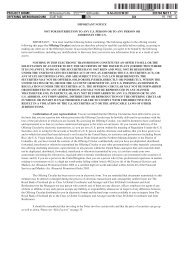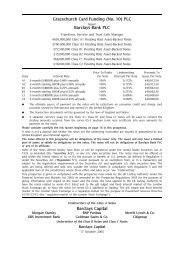Offering Circular. - SFM
Offering Circular. - SFM
Offering Circular. - SFM
Create successful ePaper yourself
Turn your PDF publications into a flip-book with our unique Google optimized e-Paper software.
Employees of the Region<br />
Year ended 31 December<br />
1998 1999 2000 2001 2002 2003<br />
Staff (number) 4,415 3,988 3,815 3,817 3,523 3,463<br />
Cost (millions of euro) 161.1 164 176 177 199 200<br />
As a result of the implementation of the Legge Bassanini (which will transfer to the Region significant<br />
functions previously performed by the Central Government) a number of personnel previously employed by<br />
the Central Government were transferred to the employ of the Region. In February 2001 approximately 320<br />
employees were transferred from the Central Government to the Region. This transfer was partially offset by<br />
the effect of the Region’s incentive programme for early retirement as well as, to a lesser extent, the transfer<br />
of employees to provinces and municipalities. It is not currently expected that any further employees will be<br />
transferred. Due to applicable accounting procedures, the costs of employees of the Region is slightly timedelayed<br />
with respect to the changes to the numbers of staff.<br />
Major Activities<br />
Regions are empowered to address general economic and social issues and are responsible for co-ordinating<br />
local administration through the provinces and municipalities and providing resources to finance provincial<br />
and municipal investment programmes. The Region’s primary role is to allocate regional funds and funds<br />
transferred from the Central Government to specific sectors and among the provinces and municipalities. See<br />
“Financial Information of the Region of Lazio”. These functions have been expanded due to the<br />
implementation of the Legge Bassanini. See “Relationship between the Central and Local Governments”.<br />
Healthcare. The primary sector in which the Region is involved is healthcare. The Region established<br />
Aziende Unità Sanitarie Locali (“ASLs”) and Aziende Ospedaliere (“AOs”) pursuant to Legislative Decree<br />
No. 502 of 30 December 1992, as amended (“Decree No. 502”), to oversee the administration of the<br />
Region’s public and private hospitals and health service providers. These entities succeeded the unità<br />
sanitarie locali and other entities referred to in Decree No. 502 and became autonomous aziende with public<br />
legal status and commercial autonomy. The capital of an ASL/AO consists of a fund (fondo di dotazione)<br />
funded by the Region. The Region is responsible for setting guidelines for health services and planning and<br />
implementing certain healthcare related programmes and initiatives, such as emergency transportation<br />
services, within the framework set forth by the Central Government.<br />
ASLs and AOs must operate efficiently and in compliance with the applicable budgetary constraints. ASLs<br />
and AOs are obliged to, inter alia, prepare annual and multi-year forecast financial statements and historical<br />
financial statements, which are subject to control by the Region, as well as an annual budget. In addition,<br />
ASLs and AOs are required to maintain accounting records to enable a comparative analysis of their<br />
expenses, income and results of operations; and allocate their own resources and determine means to cover<br />
their deficit.<br />
ASL/AO’s bodies include the general manager and a board of auditors, both of which are composed of three<br />
members, which are appointed by the Regional Board, the Ministry of the Economy and Finance and the<br />
local conference of municipalities for the healthcare matters established pursuant to Regional Law No. 18,<br />
respectively.<br />
The Central Government requires that funds transferred to the Region be utilised in three general healthcare<br />
categories (prevention, hospitals and healthcare services). As in other regions, in recent years the Region of<br />
Lazio has expended amounts on healthcare greater than its expected healthcare expenditures (see “Financial<br />
Information of the Region of Lazio – Healthcare Deficits”). Attempts to control healthcare costs commenced<br />
in 1995, following the introduction of different reforms which required healthcare pricing and<br />
reimbursement to follow prescribed prices for specific services. As a result of the reforms, the Region was<br />
given the responsibility for the planning of the healthcare budget, which is now calculated based on preestablished<br />
prices for health services. This represents a change from prior budget planning by the Central<br />
Government which was typically based on a region’s historic expenditures. In addition, the Region of Lazio<br />
42



